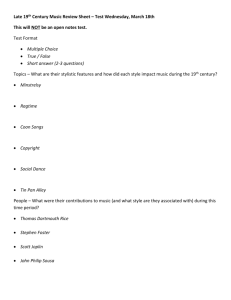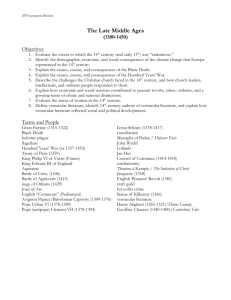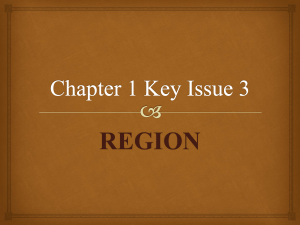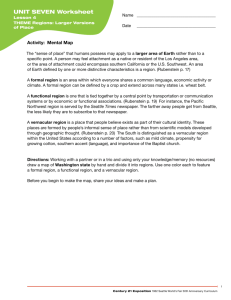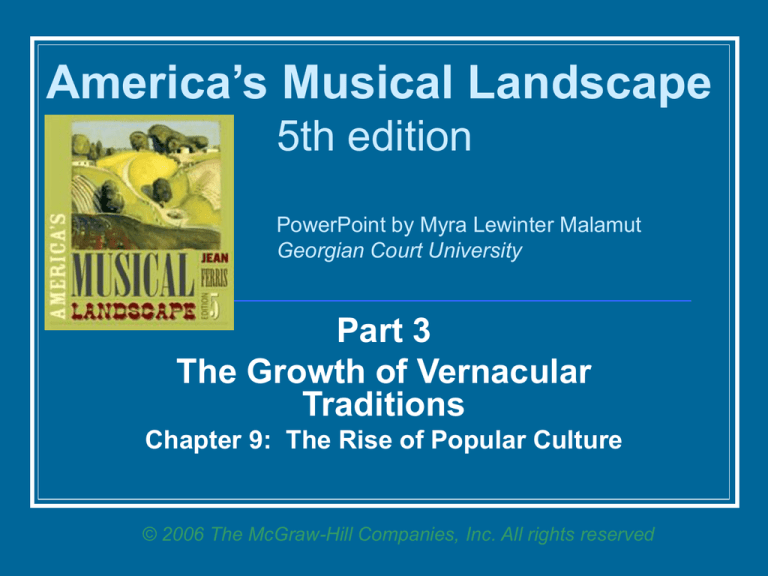
America’s Musical Landscape
5th edition
PowerPoint by Myra Lewinter Malamut
Georgian Court University
Part 3
The Growth of Vernacular
Traditions
Chapter 9: The Rise of Popular Culture
© 2006 The McGraw-Hill Companies, Inc. All rights reserved
Music in the Vernacular: Historical
and Cultural Perspective
The common, or vernacular, language of a
country is the language spoken by most of its
people
A culture’s vernacular music also is commonly
heard and understood without conscious effort on
the part of listeners
Often the term “popular” is used for vernacular
music
© 2006 by The McGraw-Hill Companies, Inc.
All rights reserved.
Part 3: The Growth of Vernacular Traditions
Chapter 9: The Rise of Popular Culture
2
Vernacular Art and Literature
Besides music, other arts of the post-Civil
War period also captured new American
flavors:
Author Bret Harte (1836-1902
Author Mark Twain (1835-1910)
Poet Walt Whitman (1819-1892)
© 2006 by The McGraw-Hill Companies, Inc.
All rights reserved.
Part 3: The Growth of Vernacular Traditions
Chapter 9: The Rise of Popular Culture
3
Popular culture thrived from the late
1930s through the early 1950s
Pulp novels, adventure comic books, swing
music, and B movies were enlivened
people’s lives
Mid-century “beat” poets borrowed
vocabulary from jazz musicians
© 2006 by The McGraw-Hill Companies, Inc.
All rights reserved.
Part 3: The Growth of Vernacular Traditions
Chapter 9: The Rise of Popular Culture
4
Visual Arts at the Turn of the
Twentieth Century
There was a new interest in the mundane in American life
The robust vigor of city life replaced the idyllic rural American
landscape
Artists:
Ben Shahn (1898-1969) imitated newspaper cartoons
Jasper Johns (1930-) and Robert Rauschenberg (1925-) introduced
everyday objects into paintings
George Segal (1924-2000) cast life-size plaster figures from live models
Pop Art was introduced in the 1960s, presenting everyday
objects including Coke bottles, lightbulbs, plus more
© 2006 by The McGraw-Hill Companies, Inc.
All rights reserved.
Part 3: The Growth of Vernacular Traditions
Chapter 9: The Rise of Popular Culture
5
Collage was a new popular art
technique
Collage was a cut-and-paste technique combining
objects of varying content and material to form a
work of art
Collage artist Romare Bearden (1912-1988)
was a member of the Harlem Renaissance movement
created stunning collages that functioned as a visual
equivalent to the jazz he loved
© 2006 by The McGraw-Hill Companies, Inc.
All rights reserved.
Part 3: The Growth of Vernacular Traditions
Chapter 9: The Rise of Popular Culture
6
Vernacular Music Included
Native American music
Anglo-American and African American dances and songs
Hymns and psalm tunes by self-taught amateurs
Music by composer Stephen Foster
Religious folk songs including spirituals and alabados
© 2006 by The McGraw-Hill Companies, Inc.
All rights reserved.
Part 3: The Growth of Vernacular Traditions
Chapter 9: The Rise of Popular Culture
7
The Emergence of Popular Music
Occurred during the period between the
Jacksonian era and the Civil War (1829-1861)
This was a period of rapid industrialization, economic
uncertainty, slavery, westward expansion, plus social,
religious, political and economic issues
Popular music provided emotional release without direct
confrontation of the issues on a personal level
© 2006 by The McGraw-Hill Companies, Inc.
All rights reserved.
Part 3: The Growth of Vernacular Traditions
Chapter 9: The Rise of Popular Culture
8
Vernacular music revealed American
traits:
Civil War era music included minstrel shows, band and circus
music, songs by Stephen Foster, performances by popular
singing families, plus American flavored songs, dances, and
instrumental pieces unfettered by European rules
Some music was conceived to provide popular entertainment
at home, in the theater or other structured setting
Some tunes evolved on an open range, cotton field, chain
gang, or battle field, offering self-expression and relief to the
lonely and oppressed
© 2006 by The McGraw-Hill Companies, Inc.
All rights reserved.
Part 3: The Growth of Vernacular Traditions
Chapter 9: The Rise of Popular Culture
9
Until recently, vernacular traditions
were not consciously preserved
Favorite pieces survived through generations
through unchanging, or slowly changing
performance practice
New sounds have been short-lived or long-lived
according to the vagaries of popular acceptance
and of the music business
Some very old tunes remain familiar, whereas
some highly popular songs have been forgotten
by the fickle public who loved them months ago
© 2006 by The McGraw-Hill Companies, Inc.
All rights reserved.
Part 3: The Growth of Vernacular Traditions
Chapter 9: The Rise of Popular Culture
10
The Rise of Popular Culture: The late
19th century and early 20th century
The gap between classical and popular music widened
There had always been music for everyday and music for
concerts, as well as religious and secular music, but these
distinctions had not necessarily been clear before this era
As time progressed complexity and dissonance increased within
classical music
Popular songwriters simplified their melodies and harmonies to
make them more accessible and acceptable to a wide audience
Popular music and classical music grew farther apart
© 2006 by The McGraw-Hill Companies, Inc.
All rights reserved.
Part 3: The Growth of Vernacular Traditions
Chapter 9: The Rise of Popular Culture
11
The last decade of the nineteenth
century:
Two phenomenal movements in popular
American music
Ragtime was primarily instrumental and led by
black musicians
Tin Pan Alley was vocal and led by American
Jews
© 2006 by The McGraw-Hill Companies, Inc.
All rights reserved.
Part 3: The Growth of Vernacular Traditions
Chapter 9: The Rise of Popular Culture
12
Ragtime
Talented black pianists
played this new highly
syncopated danceable
music for entertainment
Small bands “ragged” their
arrangements by adding
syncopation over a steady
beat
By 1897 the hot new
music was called ragtime
© 2006 by The McGraw-Hill Companies, Inc.
All rights reserved.
Part 3: The Growth of Vernacular Traditions
Chapter 9: The Rise of Popular Culture
13
Early ragtime piano music was
improvised
Nightclub audiences were captivated by this toe-tapping
style, and publishers started to show interest
This caused ragtime to be written down and highly
structured for publication
These structured pieces are considered “classic” ragtime
We now consider ragtime as a written down music
Ragtime was an American music created by black
musicians based on white European and black African
traditions
© 2006 by The McGraw-Hill Companies, Inc.
All rights reserved.
Part 3: The Growth of Vernacular Traditions
Chapter 9: The Rise of Popular Culture
14
Ragtime form:
Similar to a march
Each section is called a “strain,” referred to by its own letter.
Early rags were tonal yet some included complex harmonies and
chromatic tones; i.e., tones other than those of the major or minor
scale upon which the piece was based
The rhythm and “flavor” of ragtime derived from Africa
The spicy nature and syncopated rhythms were distinctive
characteristics of ragtime
Introduction, A A B B C C D D
© 2006 by The McGraw-Hill Companies, Inc.
All rights reserved.
Part 3: The Growth of Vernacular Traditions
Chapter 9: The Rise of Popular Culture
15
Late minstrel shows influenced
ragtime
The high-stepping plantation dance called a
cakewalk based upon the syncopated figure
short-LONG-short became a regular feature of the
finale or last scene of the minstrel show
The ragtime pianist’s left hand marked the regular
duple meter while the right hand played a highly
syncopated melody
© 2006 by The McGraw-Hill Companies, Inc.
All rights reserved.
Part 3: The Growth of Vernacular Traditions
Chapter 9: The Rise of Popular Culture
16
Ragtime performance:
Pianists included
Eubie Blake (1883-1983)
James Scott (1886-1938)
Jelly Roll Morton (1890-1941)
Scott Joplin (1868-1917)
Performances were recorded on piano rolls to be
heard “live” on player pianos long before the era
of phonographs and radios
© 2006 by The McGraw-Hill Companies, Inc.
All rights reserved.
Part 3: The Growth of Vernacular Traditions
Chapter 9: The Rise of Popular Culture
17
Scott Joplin (1868-1917)
“The King of Ragtime”
Grew up in a musical family
Studied piano and music theory with a
German immigrant musician
Joplin’s “Maple Leaf Rag”, published 1899
by John Stark who heard Joplin perform it
at the Maple Leaf Club was enormously
popular
© 2006 by The McGraw-Hill Companies, Inc.
All rights reserved.
Part 3: The Growth of Vernacular Traditions
Chapter 9: The Rise of Popular Culture
18
Listening Example 29
Maple Leaf Rag
by Scott Joplin (1868-1917)
listening guide page 148
Meter: Duple
Key: A-flat major
Outline of form: A A B B A C C D D
© 2006 by The McGraw-Hill Companies, Inc.
All rights reserved.
Part 3: The Growth of Vernacular Traditions
Chapter 9: The Rise of Popular Culture
•Notice the
short-LONG-short
cakewalk figure
which recurs
throughout the piece
•Notice the crisp
detached staccato
notes in the
descending melodic
line of the 2nd strain
19
Influence of Ragtime
Ragtime affected popular and classical music
Dancers adopted the two-step or fox-trot,
replacing other dances in popularity
James Reese Europe (1881-1919), an African American
composer and bandleader was known for the fox-trots he
composed
By the end of the twentieth century many forms of
American popular music reflected a strong black
influence
© 2006 by The McGraw-Hill Companies, Inc.
All rights reserved.
Part 3: The Growth of Vernacular Traditions
Chapter 9: The Rise of Popular Culture
20
Influence of Ragtime
White composers started writing songs with
ragtime rhythms
“Hello, My Baby!” by Joseph Howard
“Waiting for the Robert E. Lee” by Lewis F. Muir
“Yessir, That’s My Baby” by Gus Kahn and Walter
Donaldson
In the second decade of the twentieth century,
many songs by white composers were perceived
as “ragtime songs” and performers were “ragging”
(syncopating) popular songs
© 2006 by The McGraw-Hill Companies, Inc.
All rights reserved.
Part 3: The Growth of Vernacular Traditions
Chapter 9: The Rise of Popular Culture
21
Ragtime declined in popularity at the
end of World War I
Some rags became too complex for
popular appeal
Ragtime had become a precursor of jazz
Popular songs replaced piano music as the
popular music of the day
© 2006 by The McGraw-Hill Companies, Inc.
All rights reserved.
Part 3: The Growth of Vernacular Traditions
Chapter 9: The Rise of Popular Culture
22
Tin Pan Alley
The popular music expanded rapidly after the Civil
War, to Boston, Chicago, Philadelphia, Baltimore,
and Cincinnati
Songs were written to make money
Sheet music became popular
The music publishing district in New York was
dubbed Tin Pan Alley
The nickname “Tin Pan Alley” is from many pianos playing
at once
Song pluggers demonstrated music to customers
© 2006 by The McGraw-Hill Companies, Inc.
All rights reserved.
Part 3: The Growth of Vernacular Traditions
Chapter 9: The Rise of Popular Culture
23
Tin Pan Alley Songs
All were popular songs, uniform in style
The form:
Brief piano introduction
Verse-chorus form
The verses narrated a story or described
a situation or portrait
The chorus, repeated after each verse,
echoed or commented on the story
© 2006 by The McGraw-Hill Companies, Inc.
All rights reserved.
Part 3: The Growth of Vernacular Traditions
Chapter 9: The Rise of Popular Culture
24
Tin Pan Alley Songs
As listeners preferred the memorable chorus melodies,
verses became less important
By the 1920s composers were writing shorter verses and
fewer of them
Verses often were omitted from recorded performances
Finally many composers wrote songs without verses
The Golden Age of American Popular Song, from the 1920s
through the 1950s, was tied in to Tin Pan Alley
© 2006 by The McGraw-Hill Companies, Inc.
All rights reserved.
Part 3: The Growth of Vernacular Traditions
Chapter 9: The Rise of Popular Culture
25
Tin Pan Alley Songs
Many were waltzes, reflecting the popularity of
European music
“After the Ball” (1892)
“The Sidewalks of New York” (1894)
“Casey Would Waltz with the Strawberry Blonde (1895)
“Meet Me in St. Louis, Louis” (1904)
“Take Me Out to the Ball Game” (1908)
The lyrics of many of the songs reveal social
conflicts rising from women’s new active,
independent role in society
© 2006 by The McGraw-Hill Companies, Inc.
All rights reserved.
Part 3: The Growth of Vernacular Traditions
Chapter 9: The Rise of Popular Culture
26
Barbershop Quartets
Tin Pan Alley songs were often performed by
Barbershop quartets
Four unaccompanied male voices
Tenor, lead, baritone and bass
The lead voice sang melody, other voices provided close
harmony above and below
Barbershop singing is still popular today
The Society for the Preservation and Encouragement of
Barbershop Quartet Singing, and, the “Sweet Adelines”
have members who enjoy singing in the Barbershop style
© 2006 by The McGraw-Hill Companies, Inc.
All rights reserved.
Part 3: The Growth of Vernacular Traditions
Chapter 9: The Rise of Popular Culture
27
Listening Example 30
Rose (A Ring to the Name
of Rose)
by George M. Cohan
Listening guide page 152
Tin Pan Alley songs
lend themselves well
to barbershop singing
and to the creative
harmonic changes of
barbershop style:
Modest vocal range
Simple lyrics
Comfortable to sing
Simple melodies
Meter: Duple
Tempo: Moderate
Sung a cappella
Hear the emphasis to the name “Rosie” through syncopation of the
first syllable.
© 2006 by The McGraw-Hill Companies, Inc.
All rights reserved.
Part 3: The Growth of Vernacular Traditions
Chapter 9: The Rise of Popular Culture
28
Jewish American songwriters
dominated Tin Pan Alley’s years
From 1920 to about 1945 Tin Pan Alley was
popular
Jewish people were active in music as
Performing musicians
Music teachers
Popular song composers within show business
© 2006 by The McGraw-Hill Companies, Inc.
All rights reserved.
Part 3: The Growth of Vernacular Traditions
Chapter 9: The Rise of Popular Culture
29
Irving Berlin (1888-1989)
Born Israel Baline in
western Siberia, Berlin’s
family fled Russian
pogroms and settled in
1893 in a New York City
tenement
Berlin’s early days:
Sung for pennies on street
corners and in saloons
Became a singing waiter
© 2006 by The McGraw-Hill Companies, Inc.
All rights reserved.
Part 3: The Growth of Vernacular Traditions
Chapter 9: The Rise of Popular Culture
30
Irving Berlin
Worked as a song plugger in Tin Pan Alley
and wrote songs for vaudeville
Inspired by ragtime
“Alexander’s Ragtime Band,” written for a 1911
vaudeville show was Berlin’s first hit song
Berlin became one of the best-known,
popular and most enduring American
composers
© 2006 by The McGraw-Hill Companies, Inc.
All rights reserved.
Part 3: The Growth of Vernacular Traditions
Chapter 9: The Rise of Popular Culture
31
Listening Example 31
Alexander’s Ragtime Band
By Irving Berlin
Singer: Bessie Smith
Listening guide page 154
Notice the ragtime mood
and syncopated rhythm
Accompaniment: Cornet,
trombone, clarinet, piano,
banjo.
Coleman Hawkins on
clarinet, and
Fletcher Henderson on
piano both became
well-known influential
musicians.
Meter: Duple
Form: Verse-chorus
© 2006 by The McGraw-Hill Companies, Inc.
All rights reserved.
Part 3: The Growth of Vernacular Traditions
Chapter 9: The Rise of Popular Culture
32
Irving Berlin
Self-taught on piano
With others, founded ASCAP, the American Society of
Composers, Authors, and Publishers
Only played on the black keys in G-flat or F-sharp
His trick piano enabled him to modulate (change keys) to aid his
composing and adjust to the range of a singer’s voice
To ensure music creators fair compensation for public
performances of their music
Today ASCAP protects music creators’ rights, distributes
royalties, and licenses performances
Formed his own publishing company
© 2006 by The McGraw-Hill Companies, Inc.
All rights reserved.
Part 3: The Growth of Vernacular Traditions
Chapter 9: The Rise of Popular Culture
33
Irving Berlin’s Music
The rollicking tunes rhythms of many of Berlin’s songs
reveal his attraction to syncopated popular dance music
Other songs have a warm romantic mood: “Always,”
“How Deep is the Ocean, and “The Girl That I Marry”
Most frequently recorded song ever: “White Christmas”
“God Bless America” sparked controversy from liberal
commentators as well as from the right-wing
Leftists pointed out the lack of separation of church and state
Right-wingers resented a non-Christian immigrant telling God to
bless America
© 2006 by The McGraw-Hill Companies, Inc.
All rights reserved.
Part 3: The Growth of Vernacular Traditions
Chapter 9: The Rise of Popular Culture
34
Jerome Kern (1885-1945)
New York native with a sound musical education, including studies in
London
His first songs were interpolated into British shows imported to Broadway
Worked as a Tin Pan Alley song plugger and rehearsal pianist on
Broadway before writing his own shows
Songs resemble those by Berlin, yet with more complex harmonies and
sophisticated chord changes
Kern’s songs for sound movies include
“The Last Time I Saw Paris” (from Lady Be Good, 1941)
“Long Ago and Far Away” (from Cover Girl, 1944)
© 2006 by The McGraw-Hill Companies, Inc.
All rights reserved.
Part 3: The Growth of Vernacular Traditions
Chapter 9: The Rise of Popular Culture
35
Cole Porter (1892-1964)
Another major contributor to the golden age of American
popular song
Porter came from a wealthy privileged background, and was
highly trained in Paris by classical musicians
Porter’s lyrics were witty, sexy, sophisticated
The film “De-Lovely” (2004) portrayed Porter’s life
The physical pain from crushed legs in a horseback-riding
accident of 1937
A devoted marriage juxtaposed by the emotional pain of his
homosexuality
© 2006 by The McGraw-Hill Companies, Inc.
All rights reserved.
Part 3: The Growth of Vernacular Traditions
Chapter 9: The Rise of Popular Culture
36
Listening Example 32
Night and Day
By Cole Porter
Singer: Frank Sinatra
Listening guide page 159
Many of Porter’s tunes
are chromatic, move
stepwise, and are
difficult to sing
The first pitch of the
vocalist repeats 33
times in a row, and
another Note repeats
29 consecutive times
Form: Verse-chorus
Meter: Quadruple
Tempo: Moderately Slow
Fred Astaire introduced this song on Broadway
© 2006 by The McGraw-Hill Companies, Inc.
All rights reserved.
Part 3: The Growth of Vernacular Traditions
Chapter 9: The Rise of Popular Culture
37
George Gershwin (1898-1737)
As a Brooklyn, New York
native and outstanding pianist,
started out as a song plugger
on Tin Pan Alley
Age 20, became the house
songwriter for T. B. Harms
publishers
Gershwin’s song “Swanee,”
written at the age of 21, as
sung by Al Jolson became his
biggest hit song
Composed over 600 songs,
and for 30 musicals
“Someone to Watch Over
me, and “I Got Rhythm”
© 2006 by The McGraw-Hill Companies, Inc.
All rights reserved.
Part 3: The Growth of Vernacular Traditions
Chapter 9: The Rise of Popular Culture
38
George Gershwin
George Gershwin’s brother Ira (1896-1983) was
his lyricist
Like other Tin Pan Alley composers wrote movie
music
Unlike other Tin Pan Alley composers was
strongly drawn to classical music and jazz
Gershwin’s music has the sounds and flavor of jazz
His unique harmonies make Gershwin’s music
recognizable as his own
© 2006 by The McGraw-Hill Companies, Inc.
All rights reserved.
Part 3: The Growth of Vernacular Traditions
Chapter 9: The Rise of Popular Culture
39
Several Factors contributed to the
decline of Tin Pan Alley:
Change in popular taste after half a century of Tin Pan Alley
Sentimental songs during the war years became less
relevant after World War II troops were back home
New song styles became popular
Humorous nonsensical “novelty” songs
Latin rhythms
Songs from rural areas and from the West
The long 1940 ASCAP strike against radio networks:
New Tin Pan Alley recordings were not played on radio
A new organization, BMI, (Broadcast Music Incorporated),
dominated the radio waves, playing new and different music
© 2006 by The McGraw-Hill Companies, Inc.
All rights reserved.
Part 3: The Growth of Vernacular Traditions
Chapter 9: The Rise of Popular Culture
40
Chapter 9 Image Credits
Slide 13: Pianist’s Hands. © Digital
Vision/Getty Images.
Slide 30: Irving Berlin. © Corbis.
Slide 38: George Gershwin. © Corbis.
© 2006 by The McGraw-Hill Companies, Inc.
All rights reserved.
Part 3: The Growth of Vernacular Traditions
Chapter 9: The Rise of Popular Culture
41

